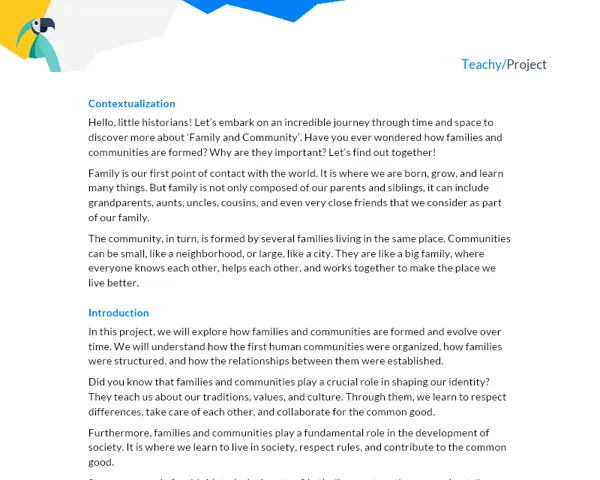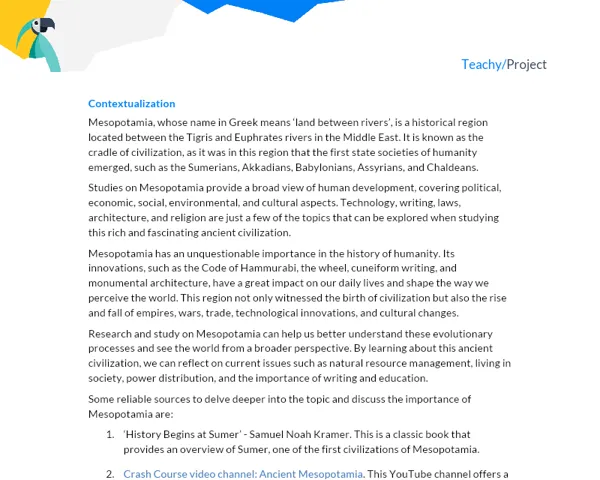Contextualization
Hello, little historians! Have you ever stopped to think about how important our family is and how it has evolved over time? Just as we study the great civilizations and events in the world, understanding our own family history is also an interesting way to learn about the past.
Our home is the first place we know when we are born. It is where we feel safe, loved, and cared for. And who is there? Our family! But what is a family? Well, a family is a group of people who live together and take care of each other. It can be formed by a dad, a mom, and children, or even by other combinations, such as grandparents, uncles, cousins, and even very close friends.
Introduction
Now, let's travel back in time, as if we were historical detectives, to understand how families were in the past. Did you know that ancient families were very different from today's families? In the past, families were very large, with many children and often all lived together, including grandparents, uncles, and cousins. They worked together, ate together, and even slept together, all in the same house!
Over time, families changed. With the industrial revolution, which happened a long time ago, people started working in factories and offices, not at home anymore. This made families smaller because people needed to live close to work.
Another important change was the role of women in society. In the past, women took care of the house and children while men worked. But over time, women gained the right to work outside the home, and nowadays, many of them have successful careers.
The Importance of Family Life
Family life is very important because it is in the family that we learn many things that help us grow and become better people. Our parents teach us to speak, walk, eat, and many other things. They also take care of us when we are sick and give us love and affection.
But family is not just that. Family is also where we learn about respect, sharing, helping others, loving, and being loved. In the family, we learn about our ancestors, our culture, and the history of our country.
So, are you ready to embark on this journey through time and discover more about family life? Let's go!
Practical Activity: "The Genealogical Tree of My Past"
Project Objective
To stimulate research, teamwork, and creativity of students, while deepening knowledge about the importance of family and its evolution over time.
Project Description
The groups of students will create a "Genealogical Tree of My Past," which is a drawing or a poster that shows the history of their family. It should include the names of family members, birth dates, photos (if possible), and a brief description of each.
In addition, students should research and write about how family life has changed over time, from grandparents to parents, through their own childhood. With this, they will realize how families have changed, for example, in task division, size, and composition.
Necessary Materials
- Large sheet of cardboard or kraft paper
- Colored pens, colored pencils, crayons
- Blunt scissors, glue, tape
- Family photos (if possible)
- Internet access for research (with teacher or parent supervision)
Step by Step
-
Group Formation: Divide the class into groups of 3 to 5 students. Ideally, groups should be formed with students from different families so they can compare stories.
-
Group Discussion: Each group should discuss the importance of family and how they live in their homes. They should try to remember what the routine is like at home, who the family members are, and who does what.
-
Planning the Genealogical Tree: With the help of the teacher, groups should plan how the genealogical tree will be. They should define who will be the trunk of the tree (the student who will represent themselves) and how the other family members will be represented (branches of the tree).
-
Research: Students should research their own family. They can interview parents, grandparents, or other relatives who live with them to learn more about the family history. The goal is to discover information such as the full names of family members, birth dates, and, if possible, old photos.
-
Creation of the Genealogical Tree: With the collected information, students should create the genealogical tree on the cardboard or kraft paper. They should include names, photos (if available), birth dates, and, if possible, a brief description of each family member.
-
Writing the Report: Students should write a short report about what they discovered in the research. They should compare today's families with the old ones, talking about how families have changed over time.
-
Presentation: Each group will present their genealogical tree and report to the class. During the presentations, students should pay attention and compare their family stories with those of their classmates.
This project should be completed in two weeks. During this period, the teacher should monitor the progress of the groups, answer questions, encourage research and creativity, and, most importantly, ensure a respectful and cooperative environment among students.
Remember: each family is unique and special, and that's what makes this project so interesting! Good luck, little historians!


